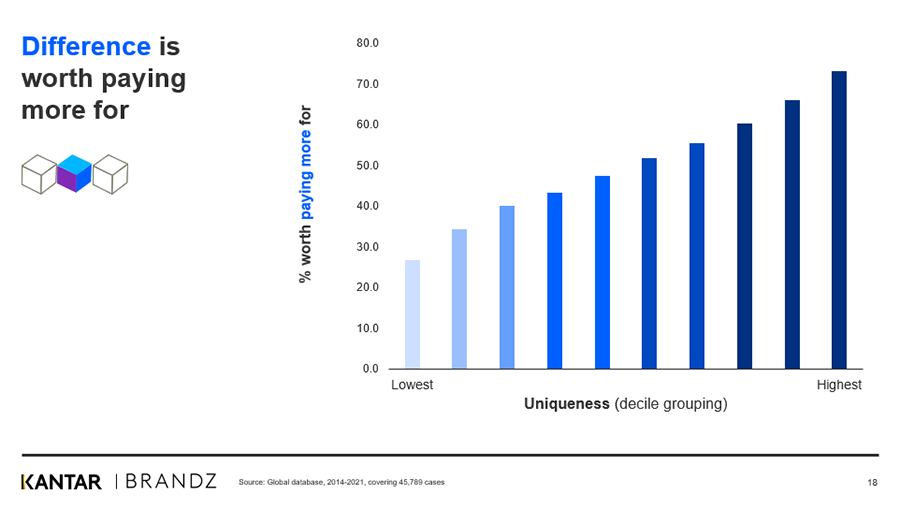WARC Strategy held three incredible sessions during last month’s Cannes LIONS Festival of Creativity. The sessions looked at three key areas impacting strategy – also explored in WARC's Future of Strategy 2022 survey, which is now live. If you work in strategy or planning, please complete the short survey before the deadline of the 13th July. All respondents will receive a copy of the report analysing the current state and future trends of the discipline.
1. An evolving model of brand growth
Dom Boyd, Managing Director, UK Insights, presented new research from Kantar looking at the DNA of a breakthrough brand. The research, conducted in partnership with Oxford’s Saïd Business School, looked at the critical factors of brands that have created ‘breakthrough’ growth – a fast-growing subset of Kantar’s BrandZ database.
The research indicates that creating difference – not just distinctiveness – is a brand’s ultimate competitive weapon, or as Boyd put it, “difference is the rocket fuel for breakthrough brand growth”.
When difference is applied meaningfully, to meet people’s needs, and when it’s supported by strong marketing that drives salience, it drives brand growth 2.5 times higher than brands that lack difference, explained Boyd.
These brands are seen as disruptive and reshaping their category. They outperform on innovation and customer experience, which crucially support premium pricing.

While communications are of course crucial for brand growth, the brand growth model needs to evolve, argued Boyd.
Which means taking into account critical factors such as product, services, brand responsibility, innovation and experience, which play a role in driving preference, margin and pricing power, and influence the entire customer journey, pre-, during and post-purchase.
Crucially, the research suggests that any brand can achieve breakthrough growth, not just tech brands.
2. The shift from trickle down to ‘bubble-up’ culture
This year’s future of strategy debate looked at strategy in the era of fragmentation, with long-time WARC contributor Oliver Feldwick, head of innovation at The&Partnership, and Ana Andjelic, global c-suite executive.
With the exception of major sporting events, the days of placing an advert in a spot on a prime-time TV show (think X Factor or American Idol) to reach an audience at scale are now few and far between. Today, audiences are fragmented across multiple channels, touchpoints and platforms, their attention is fragmented, and culture is now created at rapid speed, with brands playing catch-up.
“The chances to reach and influence mass culture, and the routes to do that are a lot more complicated” than ten years ago, said Feldwick. Today, culture is created by the likes of Francis Bourgeois, an English trainspotting enthusiast and “TikTok content global phenomenon”, who has accrued a huge following on social media, and has since been invited to prestigious and exclusive events as well as becoming the face of luxury brand Gucci.
These creators are challenging the traditional gatekeepers of ‘trickle down’ culture, and creating their own, a ‘bubble up’ culture, where “small organic things can break through and get noticed and become a new cultural force”, Feldwick explained. While this is exciting, the tempo and speed of culture leaves many brands in a position where it’s harder to keep up with all the changes.
So how do marketers reach audiences in today’s fragmented landscape? Feldwick sees three ways to do this – mass marketing, smart one-to-one marketing and marketing to tribes/communities, the latter being an underexplored area. The approach will of course depend on the budget.

This rise of niche communities, or taste tribes, and how brands can reach people based on their values, interests and tastes, was the focus of Ana Andjelic’s talk. To reach fragmented audiences, brands should “create many doors in”, by personalising not just the product assortment but also the communication and creative that goes to many different niches or groups.
Another important consideration is remembering that people are social beings who are influenced by others. “People buy things because their friends buy them, and this social dimension isn’t taken into account by consumer psychographics,” said Andjelic. “People are influenced by the networks they belong to.”
3. Purpose-led companies must come before purpose-driven ads
Brand purpose – a reason why a brand exists beyond making profit – was popularised in 2011 by Jim Stengel, former global marketing officer for Procter & Gamble, who argued that brands with a purpose/ideals have a competitive advantage. Its importance has been hotly debated ever since. Some think demonstrating a brand’s positive contribution to society via their marketing is a vital element of modern brand building. Others regard it as a distraction, arguing that it undermines effectiveness.
For Yael Cesarkas, VP, Executive Strategy Director at R/GA San Francisco, purpose marketing is “explosive and superficial”. Ad Age’s strategist of the year announced that “there are very few brands in the world, that have earned the right, and have the credibility, to pull off a credible, successful and effective purpose-driven marketing campaign”. Cesarkas identified three main issues underpinning the progressive case against purpose marketing:
- Using the marketing department as “the back door into turning an orgaisation that is not purpose-driven into a purpose-driven organisation”.
- Using purpose as an awareness play.
- Taking leaps that lead to messaging that is “tangential to what we’re actually trying to sell”. These PR-facing activations only serve to fuel consumer cynicism and distrust.
The bottom line? “People want purpose-driven companies, not purpose-driven ads”, Cesarkas declared. In other words, purpose must be baked into how a company operates every day, across all stakeholders: employees, supply chains, communities, the environment, consumers and investors.
Complete WARC's Future of Strategy 2022 survey before 13 July and get a copy of the Future of Strategy report analysing the current state of and future trends in the discipline.

